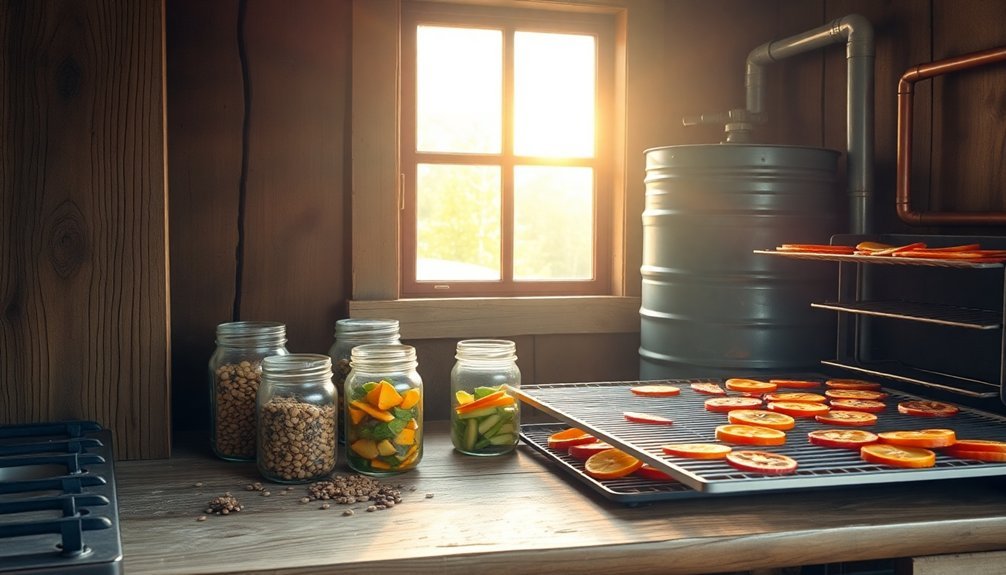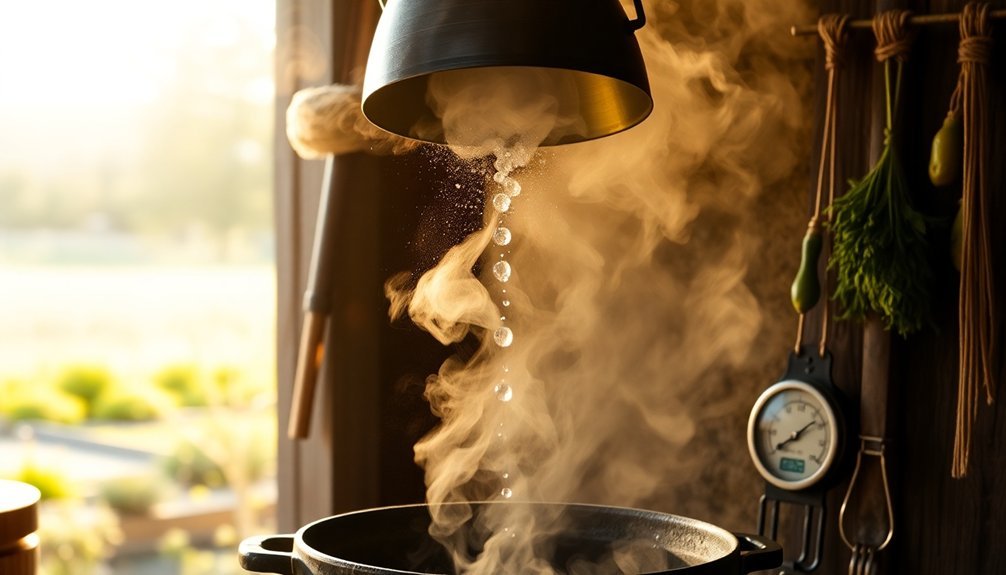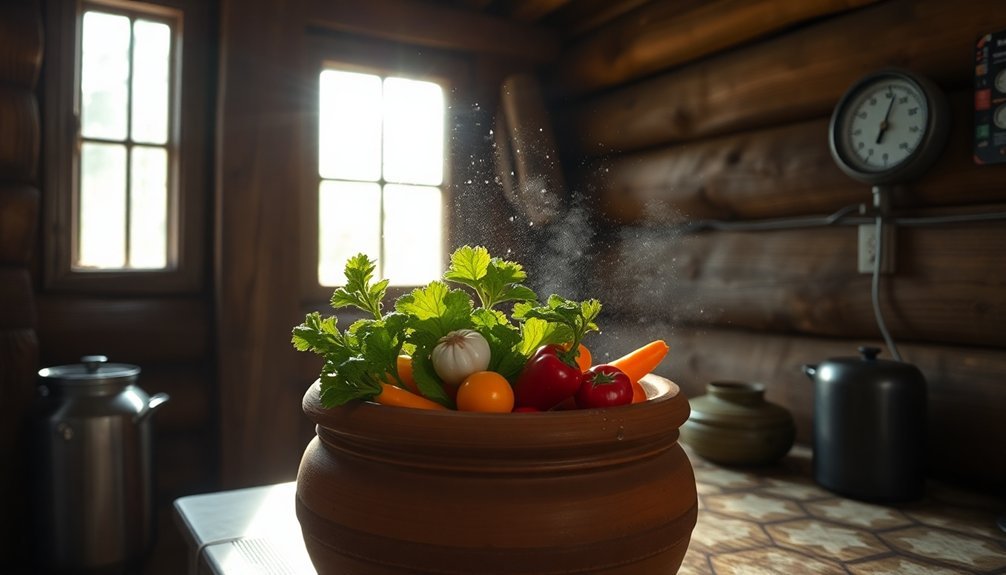Foods need less water when cooking off-grid because you'll use more efficient moisture retention methods. Through covered cooking techniques and proper steam capture, you'll preserve the natural juices and water content already present in your ingredients. Solar cooking specifically requires about half the typical liquid amounts since it creates an insulated environment that traps and recirculates moisture rather than letting it escape. You'll also maintain nutrients better with these methods since less water evaporates during the cooking process. Understanding these water-saving principles can transform how you approach off-grid meal preparation.
Water Loss Prevention Methods

When living off-grid, preventing water loss becomes essential for maintaining a sustainable water supply.
You'll need to design your distribution network carefully to minimize waste and maintain consistent pressure throughout your home. Installing pressure tanks and regulators helps control water flow while protecting your plumbing system from damage. Regular water quality testing helps identify potential issues before they affect your system's efficiency.
Consider implementing gravity-fed systems where possible, as they're more reliable and energy-efficient than electric pumps.
When you must use pumps, choose energy-efficient models that match your specific needs. You'll also want to use high-quality, durable containers for water storage, avoiding glass due to breakage risks.
Regularly inspect your containers and plumbing for leaks or damage. By incorporating water-conserving fixtures and sustainable practices, you'll markedly reduce waste while ensuring your system's longevity.
Solar Cooking Temperature Control
Since solar cooking relies heavily on natural sunlight, mastering temperature control becomes essential for consistent results.
You'll find that different solar cookers offer varying temperature ranges – from 65°C for gentle baking to 400°C for high-heat grilling. To control these temperatures, you'll need to understand your cooker's design and capabilities.
You can adjust heat levels by repositioning reflectors, modifying exposure time, or using different cooking vessels. Unlike traditional cooking methods, the food should not be stirred to maintain trapped heat inside the cooker.
Parabolic cookers give you quick, intense heat perfect for stir-frying, while box cookers provide steady, lower temperatures ideal for slow-cooking.
For precise control, consider using dark-colored, matte-finished pots that maximize heat absorption. The insulation in your solar cooker helps maintain steady temperatures, and some models even include heat storage features for cooking after sunset.
Steam Capture Techniques

As you explore off-grid cooking methods, efficient steam capture becomes essential for conserving water and maximizing your food's moisture content.
You'll want to position your cooking setup at a three-quarter angle to trap rising steam effectively, similar to how food photographers capture steam visually.
To retain precious water vapor, cover your cooking vessel with a tight-fitting lid and minimize unnecessary lifting. Thermal cooking techniques with insulated wraps help maintain consistent steam and reduce overall water needs.
You can enhance steam capture by using proper heat control and ensuring your cookware maintains consistent temperatures.
When you need to check your food, do it quickly to prevent steam loss.
For best results, let your dishes rest covered after cooking – this allows the steam to redistribute throughout the food, maintaining moisture without requiring additional water.
These techniques are particularly valuable when water resources are limited.
Covered Cooking Benefits
Cooking with covered vessels offers substantial benefits for off-grid water conservation and food preparation. When you're using insulated cooking vessels and covered methods like solar or cob ovens, you'll retain more moisture in your food while using less water overall.
These cooking approaches trap heat effectively, allowing for slower, even cooking that preserves both nutrients and natural moisture content.
- Lock in steam and moisture during the entire cooking process
- Reduce the need for additional water during food preparation
- Cook at lower temperatures while maintaining food's natural juices
- Minimize evaporation through efficient heat and moisture retention
- Preserve nutrients that might otherwise be lost through excessive water use
These covered cooking methods are particularly effective in off-grid settings where water conservation is essential, and they'll help you make the most of your limited resources.
Moisture Circulation Design

While managing moisture effectively is crucial for any kitchen, it becomes even more important in off-grid settings where water conservation directly impacts your daily life. You'll need a well-designed ventilation system that includes both mechanical and natural components to control moisture levels and guarantee proper air exchange.
| Ventilation Type | Primary Benefit | Best Usage |
|---|---|---|
| Range Hood | Removes cooking vapors | During cooking |
| HRV System | Recovers heat while venting | Year-round |
| Natural Venting | Energy-free air exchange | Moderate weather |
To maximize moisture control, you'll want to combine proper insulation with strategic air circulation. Install external insulation like Dow XPS foam to prevent condensation, and use automatic stack dampers to maintain consistent airflow. Don't forget to incorporate water-saving features like low-flow faucets and greywater systems to complete your moisture management strategy.
Liquid Ratios For Solar Cooking
You'll find that solar cooking requires only half the typical liquid amounts since the enclosed environment naturally retains moisture and creates an efficient steam cycle.
Your food's natural moisture recirculates within the solar cooker, collecting as condensation on the lid and dripping back onto the food for continuous basting.
This self-contained moisture system prevents drying while concentrating flavors, making it unnecessary to add extra water during the cooking process.
Solar Heat Water Retention
Because solar cookers concentrate and retain heat differently than conventional stoves, they require less water in most recipes.
The insulated environment and greenhouse effect created by these cookers trap moisture more effectively, preventing evaporation. You'll find that the combination of efficient heat concentration and superior insulation means liquids stay in your food rather than escaping as steam.
- Glass lids and plastic covers create a sealed environment that recirculates moisture
- High-performance solar cookers can reach temperatures above 550°F while maintaining humidity
- Vacuum tube designs provide exceptional insulation, keeping water content stable
- Trapped moisture continues cooking your food even when clouds appear
- Borosilicate glass and metal linings enhance heat distribution while preserving moisture
The result is more flavorful food that retains nutrients better, since you're not losing precious liquid through excessive evaporation.
Steam Control Benefits
The precise control of steam and liquid ratios stands at the heart of successful solar cooking. You'll need to use about half the liquid compared to traditional recipes, especially when baking cakes.
By cooking foods in their natural state – like potatoes in skins and corn in husks – you'll preserve more nutrients while using less water.
You won't have to worry about burning your food, as solar cooking maintains even heat distribution similar to a slow cooker. The controlled steam environment prevents vegetable discoloration and allows you to bake, boil, steam, or roast effectively.
Since water doesn't boil away, nutrients stay locked in your food, resulting in better flavors and textures. Plus, you're using free solar energy, which means you won't heat up your kitchen or increase your electricity bills.
Condensation Collection Systems
While maximizing water efficiency in solar cooking, condensation collection systems play an essential role in preserving and reusing precious liquids.
You'll find that solar stills with plastic film or glass can effectively capture evaporated water, especially when angled at 30 degrees.
By maintaining a water depth of 25mm and using weighted centers to create funnel effects, you can collect up to 4.6ml of water daily from a 10cm surface.
- Use transparent materials like plastic film or glass for ideal evaporation capture
- Position collection surfaces at 30-degree angles to maximize condensation gathering
- Keep water depth at 25mm (1 inch) for efficient operation
- Create funnel shapes with weighted centers to direct water flow
- Expect yields of up to 4.6ml daily per 10cm of collection surface
These systems integrate perfectly with your solar cooking setup, helping you maintain sustainable water usage in off-grid situations.
Frequently Asked Questions
How Does Altitude Affect Water Requirements in Off-Grid Cooking Systems?
You'll need less water at higher altitudes since it evaporates faster and boils at lower temperatures. However, you'll want to cover your food well to prevent moisture loss during longer cooking times.
Can Recycled Greywater Be Safely Used for Food Preparation Off-Grid?
You shouldn't use recycled greywater for food preparation, as it contains harmful pathogens and contaminants. It's not safe for cooking or cleaning food items, even off-grid. Use only clean, potable water instead.
What Role Do Different Pot Materials Play in Water Conservation?
Your pot material choices greatly impact water conservation. You'll save more water with porous clay pots like ollas that gradually release moisture, while sealed tanks help you store and protect water for long-term use.
How Do Seasonal Temperature Changes Impact Water Needs in Off-Grid Cooking?
You'll need more water in summer as foods cook faster and evaporate quickly. In winter, you'll conserve water since foods retain moisture better and evaporation slows due to cooler temperatures.
Does Food Texture Change When Using Water-Efficient Off-Grid Cooking Methods?
Yes, you'll notice texture changes when using water-efficient methods. Your food may become denser with slow cooking, crispier with dry heat, or chewier with dehydration, but proper technique helps maintain desired consistency.
In Summary
You'll find that foods need less water when cooking off-grid because proper moisture management techniques keep the water where it belongs – in your food. By using covered cooking methods, steam capture systems, and controlled solar temperatures, you're preventing unnecessary evaporation. These efficient cooking practices mean you'll use up to 30% less water while still achieving perfectly cooked, moist results in your off-grid kitchen.





Leave a Reply